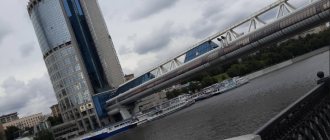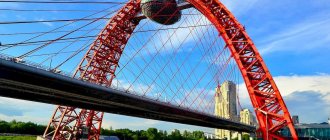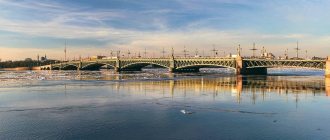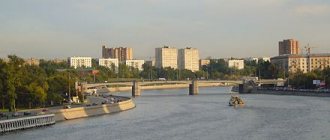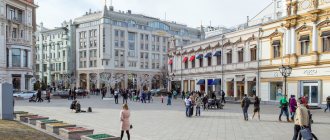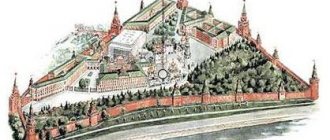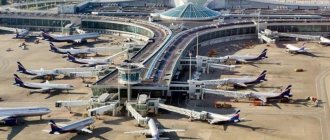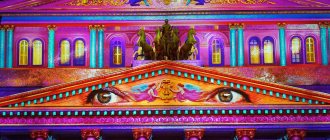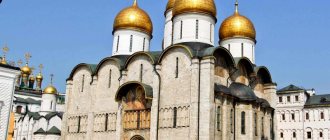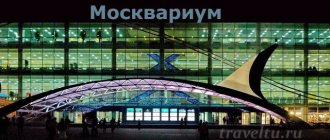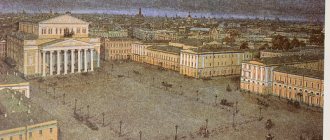Emergency
In the summer of 1943, Soviet troops and the Wehrmacht were preparing to clash in a decisive battle on the Kursk Bulge. The Third Reich, realizing that the longer the war went on, the less chance of success remained, planned to deliver a fatal blow, taking revenge for the defeat at Stalingrad. The Soviet command was preparing to repel the threat.
On June 3, 1943, an emergency occurred in the very center of Moscow - shots rang out on the Bolshoy Kamenny Bridge, a stone's throw from the Kremlin. Police officers discovered the lifeless body of a girl, as well as a wounded young man, who was immediately taken to the hospital.
Doctors immediately gave a disappointing prognosis regarding the patient’s condition - he was not going well. And indeed, the young man soon died.
The shooting in the center of the capital at the height of the war immediately raised suspicions of sabotage. And when the names of the dead became known, the people in uniform became completely hot - Nina Umanskaya , daughter of the USSR Ambassador to Mexico Konstantin Umansky , and Vladimir Shakhurin , son of the People's Commissar of the Aviation Industry Alexei Shakhurin .
Vladimir Shakhurin. Photo: Commons.wikimedia.org
But that was not all. According to experts, Volodya Shakhurin was the shooter. First he killed Nina and then committed suicide. Moreover, he was armed with a German “Walter”.
Big Stone Bridge
The Bolshoy Kamenny Bridge is one of the bridges spanning the Moscow River near the Kremlin. It connects Borovitskaya Square, as well as Mokhovaya and Znamenka streets with Bolshaya Polyanka Street on Bolotny Island, but the transport component is not its only role. Its location in the historical center of the capital and excellent views of the surrounding area make the Big Stone Bridge an important tourist attraction.
Now the Bolshoi Kamenny Bridge is called stone only formally, but in the past there was actually a bridge built of stone across the Moscow River. Initially, a ford appeared at this place, through which the road from Ryazan to Novgorod went, then a “living” wooden bridge was built. In 1643, Tsar Mikhail Fedorovich issued a decree according to which Strasbourg engineer Yagon Christler began construction of a stone bridge, which, after construction was completed in 1692, received the name All Saints. The All Saints Bridge, which amazed citizens with its scale (170 meters long and 22 wide, 8 arches with spans up to 15 meters), became one of Moscow’s wonders, however, by the 1850s it had become very dilapidated, and they decided to demolish it; The demolition was difficult - the solid masonry had to be blown up. Already in 1858, on the site of Vsekhsvyatsky, according to the design of engineers Voskoboinikov and Tannenberg, a metal three-span bridge was erected, but a little later, already under Soviet power, it also became obsolete. Instead, in 1938, a modern bridge was built a little further downstream, called Bolshoi Kamenny.
The bridge is located literally under the walls of the Kremlin, so it offers an excellent view of the ancient Moscow fortress: the entire southern wall from Vodovzvodnaya to Beklemishevskaya Tower, the Grand Kremlin Palace, the Archangel Cathedral, and the Ivan the Great Bell Tower are clearly visible. the Cathedral of Christ the Savior and the famous House on the Embankment (Government House) - a residential complex of the Central Executive Committee-SNK of the USSR - dominate
Other iconic sights of Moscow are visible a little in the distance: the Pashkov House, the Pertsova apartment building, the building of the Presidium of the Russian Academy of Sciences (“Golden Brains”), book houses on Novy Arbat, the Moscow City International Business Center, the high-rise building of the Swissotel Krasnye Holmy hotel, a public garden on Bolotnaya Square and a number of others. There are also Stalinist high-rise buildings: from different points you can see the high-rise buildings of Moscow State University and the Ministry of Foreign Affairs, as well as a residential building on Kotelnicheskaya Embankment.
An interesting and dynamic view opens onto the embankments adjacent to the bridge: the Kremlin, Prechistenskaya, Sofia and Bersenevskaya, as well as the automobile Bolshoy Moskvoretsky Bridge at the far end of the southern wall of the Kremlin and the pedestrian Patriarchal Bridge near the Cathedral of Christ the Savior. During rush hours, the embankments are filled with traffic, and from the Bolshoy Kamenny Bridge you can see another famous city landmark: Moscow traffic jams.
You can get to the Bolshoy Kamenny Bridge from the Borovitskaya and Kropotkinskaya metro stations, as well as from a number of other stations located in the center.
Pistol from Mikoyan
To call what happened a scandal is to say nothing. Both victims lived in the famous “House on the Embankment”, where the families of the Soviet elite lived, studied at the 175th Moscow school, in the same place as Stalin’s children, Molotov’s daughter, Gorky’s granddaughter, Mikoyan’s sons, etc. And Umansky Sr. , and Shakhurin Sr. were in good standing with Joseph Vissarionovich, and here is such a turn.
Naturally, with a question about the origin of the weapon, the first thing they came to was the boy’s father, People’s Commissar Shakhurin. But the inconsolable Alexey Ivanovich said that he was seeing this “Walter” for the first time in his life and had no idea where his son got it.
It turned out that Volodya was given the pistol by Vano Mikoyan , the son of Deputy Chairman of the Council of People's Commissars, member of the Politburo Anastas Mikoyan . Vano said that the captured pistol was brought from the front by his older brothers.
Nina was 14 years old, Shakhurin was 15. According to their friends, they were friends and friendship eventually grew into first love.
Nina Umanskaya (center) with her father Konstantin Alexandrovich and mother. Early 1940s Photo: Commons.wikimedia.org
All Saints Bridge
On the site of the later bridge, apparently from the very beginning of Moscow, there was a ford through which the road from Ryazan to Novgorod went through Volok Lamsky, known as Volotskaya [1]. Then a floating (“living”) bridge was built, which was raised to allow ships to pass through. Against the bridge at the end of the 16th century. The All Saints (Water) Gate of the White City was built, named after the Church of All Saints, which stood nearby (near the modern Cathedral of Christ the Savior), on the moat. In 1643, by decree of Tsar Mikhail Fedorovich, a craftsman from Strasbourg, Yagon Christler, began construction of the first permanent stone bridge across the Moscow River at the All Saints Gate. After the death of the king and the master, construction was stopped, as the plan was considered too bold and expensive. It was resumed and completed in 1682-1687 on the initiative of Princess Sophia and Vasily Golitsyn according to the old model of Christler (who left behind a wooden model of the bridge) of the “bridge stone craftsman” monk Elder Philaret. After completion in 1692, the bridge received the name of All Saints
. Other names of the bridge were: Bersenevsky and New Kamenny (Old Kamenny meant the Trinity Bridge across the Neglinka, near the Trinity Tower of the Kremlin). Over time, the bridge acquired its modern name. The bridge was, however, not exactly on the modern site: it began at the foot of the modern House on the Embankment (the red line of which is correlated with the line of the old bridge) and led to the place where Lenivka Street now opens to the river (in those days it was a passage to All Saints Gate).
The length of the bridge was 170 m, the width was 22 m. The bridge had 8 arches, the middle ones served to pass rafts and boats and had spans of up to 15 m. In front of the bridge on the Zamoskvoretsk side, a bridgehead tower was built - Shestivratnaya, which, as the name indicates, had six gate openings (actually three double gates), as well as several pyramidal tiers, correlated with the tiers of the Borovitskaya tower of the Kremlin, and two crowning tents crowned with double-headed eagles.
The funds spent on the construction of the bridge so amazed contemporaries that a saying arose that existed in Moscow for more than a hundred and fifty years: “More expensive than the Stone Bridge!” (about the value and high cost of something). In the 19th century, a saying was also recorded in the Nizhny Novgorod province: “A stone bridge is better!” In general, according to the testimony of Moscow historian I.M. Snegirev, who still saw the old bridge, it “was considered one of the capital’s wonders, on a par with Ivan the Great, the Sukharev Tower, the Tsar Bell, and the Tsar Cannon.”
Since the bridge was 3-4 times wider than the largest Moscow streets, it was built up on both sides. In Peter’s times, on the bridge stood: the chamber of the Predtechevsky Monastery and four stone tents of Prince Menshikov, a tobacco customs house and a beer yard. At the end of the bridge there was a tavern called “Zavernyayka”. The Six Gate Tower housed the Tavern Office and a prison for those convicted of tavern (secretly making wine). Below them were galleries called upper walkways, where Muscovites gathered to walk and drink wine and beer; from the galleries a wooden ramp led to the embankment, to the so-called Tsaritsyn meadow and to Bersenevka. There was a beer glacier right under the bridge. Water-powered flour mills with dams and diversion gates were attached to the diversion bulls; the millers lived right there, in the Six Gate Tower.
All sorts of “thieves” and “dashing people” gathered under the bridge, and one of the spans on the left bank, the “ninth cell,” was especially notorious. As evening approached, Muscovites tried not to walk past it.
In 1731, by decree of Anna Ioannovna, the mills were demolished and the bridge piers were cleared. During the spring flood of 1783, the bridge was badly damaged: as Moscow commander-in-chief Count Chernyshev reported to Catherine: “Three arches of the bridge collapsed... and the 11 stone shops on them with various furniture of the merchant Yepanishnikov, worth 1100 rubles. One who was standing on the bridge at that time fell and was killed, and a fisherman who was under the bridge and two women who were at the shore washing their clothes were crushed by the ruins.”[2]. In August 1786, the bridge was again damaged by floods. In view of this, by order of the new commander-in-chief, Earl Bruce, the bridge was repaired and reconstructed. During the reconstruction, which lasted until 1792 and cost 213,000 rubles, the bridge was strengthened, the benches were demolished, the Six Gate Tower was dismantled, and railings were installed on the sides.
In the mid-1850s. It was decided to demolish the dilapidated bridge. The demolition was carried out with great difficulty, due to the strength of the masonry, which had to be blown up. “How much effort and dedication it took to break this two-century-old monument! - writes I.M. Snegirev, who witnessed its destruction. - The very difficulty of breaking it proved the strength of its masonry and the goodness of the material, from which only one part was enough to build a huge house. Moscow residents gathered with curiosity and regret to look at the destruction of this bridge, which had long been revered as one of the wonders not only of our ancient capital, but of all of Russia in general.”
Deadly parting
Nina's father, Konstantin Umansky, was considered one of the best Soviet diplomats. From 1939 he was the USSR plenipotentiary representative to the United States, and in May 1941 he became the Soviet ambassador in Washington. At the end of 1941, Umansky returned to Moscow, where he became a member of the board of the NKID of the USSR.
In May 1943, Konstantin Alexandrovich received a new appointment - this time he was to head the Soviet embassy in Mexico. His wife and daughter were preparing to go with him.
For Volodya Shakhurin, the prospect of parting with his beloved turned out to be unbearable. He invited Nina to stay in Moscow, but the girl refused. And, frankly speaking, such freedom was not in her power at all, especially given wartime.
But Volodya continued to stubbornly believe that he would achieve his goal. Having come to his friend Vano Mikoyan, he asked him for the captured “Walter”. The son of People's Commissar Mikoyan told investigators that Volodya wanted to scare Nina. It’s not entirely clear what exactly he did - either he wanted to force her to stay at gunpoint, or he was going to demonstrate that he was ready to die because of parting with her.
Shakhurin made an appointment with the girl on the steps of the Bolshoy Kamenny Bridge. Obviously, Nina approached her without fear, not even suspecting that Volodya would appear with a weapon.
Article on the topic
Cinema against fascists. As the chronicle of the war showed at the trial in Nuremberg What and how the young people talked about, now no one will know. Obviously, Nina made it clear to her Romeo that she would not contradict her parents and would go to Mexico with them. Perhaps Volodya had a breakdown, or maybe he just accidentally pulled the trigger, just trying to impress. Be that as it may, Nina died on the spot. Realizing what had happened, Vladimir sentenced himself.
Secret organization of “golden youth”
The drama about first love could have ended there, but investigators, looking into the reasons for what happened, found Volodya Shakhurin’s diary. And there…
At the height of the Great Patriotic War, the son of the People's Commissar of the Aviation Industry outlined plans for an organization called the “Fourth Empire.” As it turned out, Volodya was familiar with the works of Hitler, which in the USSR were available only to people with special access (his father had one), and drew inspiration from them. He divided his like-minded people into Reisführer, Gruppenführer, and talked about the need for regime change in the Soviet Union.
Shakhurin was going to do this in an evolutionary way - his like-minded people had to grow up, gradually climb the career ladder and ultimately concentrate power in their own hands. In the meantime, the leader of the organization planned to devote time to study, physical improvement, parachute jumping, etc.
And in the diary there was a list of members of the “Fourth Empire”: Vano and Sergo Mikoyan , Pyotr Bakulev , son of a prominent surgeon, academician Alexander Bakulev, Felix Kirpichnikov , son of General Pyotr Kirpichnikov , head of the Defense Industry Department of the State Planning Committee, Artem Khmelnitsky , son of General Rafail Khmelnitsky , the head of the Central Exhibition of Captured Weapons in Moscow, and other representatives of the Soviet “golden youth”.
Doctoral defense. What did Anastas Mikoyan feed the Soviet people? More details
It is possible, however, that mentions of admiration for Hitler and Nazi symbols are just a later invention. Otherwise, it is difficult to explain why the competent authorities treated this story with great restraint.
Story
Since the ancient times of the founding of Moscow, there was a ford across the river on the site of the modern bridge. The Volotsk road from Ryazan to Novgorod passed here. Later, local residents built a floating wooden bridge across the water, which could be opened if necessary. This is very practical in cases where it was necessary to let a ship pass or when enemy raids were carried out. However, there were also serious disadvantages of the “live” crossing: such bridges were very quickly broken by floods and could not withstand heavy loads. With the growth of the population of Zamoskvorechye in the 15th century, there was an awareness of the need for reliable stone construction. Therefore, in 1643, Tsar Mikhail Fedorovich issued a decree to begin the construction of such a bridge according to the design of the master from Strasbourg Anze Yagon Christler. However, due to the premature death of the Tsar, construction was stopped and resumed only in 1682 by Prince V. Golitsyn, the favorite of Princess Sophia. It turned out to be so expensive to build the crossing that the expression “More expensive than the Stone Bridge” took root among the common people, meaning the high cost of something. In 1692, the bridge began to be called All Saints. The object turned out to be so durable and monumental that it became one of the attractions along with the Bell Tower of Ivan the Great, the Sukharevskaya Tower and others. The building began to enjoy popularity, life was always in full swing here: benches and tents were built on the bridge, and a haven for thieves and murderers formed under the bridge.
Over time, the landmark deteriorated and became more and more unusable. In the 1850s, it was decided to demolish the bridge. This process turned out to be very labor-intensive due to the high strength of the masonry, which eventually needed to be blown up.
In 1858, a new Stone Bridge was built on this site according to Tannenberg's design. And although it was now made of metal structures and was not so impressive to local residents, it was the first metal bridge in Moscow.
Soon it too fell into disrepair, so in 1938 a modern crossing was installed a little further down the Moscow River, which has survived to this day. It received its current name, the Big Stone Bridge. The project was created by a group of professionals: engineer N.Ya. Kalmykov, architects V.A. Shchuko, V.G. Gelfreich, M.A. Minkus. Later, the bridge was moved to Borovitskaya Square, since the narrow Lenivka made access to it difficult.
To understand and to forgive
Those who appeared in Shakhurin’s diaries were summoned for interrogation and even, according to some reports, were kept in solitary confinement for some time. However, no information was received about the real conspiracy, that the organization existed as such. The “Fourth Empire” was more like a game - quite strange for the offspring of Soviet party and government officials, but still not anything serious.
Perhaps she would never have come out at all if not for the drama on the Big Stone Bridge.
They say that Stalin , after listening to the report on the results of the investigation, said briefly: “Wolf cubs.” It was decided to start re-educating the alleged “conspirators” - parents were strongly recommended to temporarily remove their children from the capital, introducing them to something socially useful in the spirit of loyalty to party ideals.
Article on the topic
Disputes about Stalin. Best friend of athletes or bloody tyrant? None of the members of the “Fourth Empire” had their lives broken. Vano Mikoyan became an aircraft designer, his brother Sergo became a Doctor of Historical Sciences, a specialist in Latin America. Pyotr Bakulev, having graduated from the Moscow Aviation Institute, received a Doctor of Technical Sciences degree, becoming famous in the field of radar.
Forever close
Konstantin Umansky, having buried his daughter, went with his wife to his place of service in Mexico. In 1944, he was also appointed Soviet envoy to Costa Rica. In January 1945, the diplomat flew from Mexico to Costa Rica on official business. The plane crashed immediately after takeoff, and his wife died along with Umansky.
Alexey Shakhurin was repressed in 1946 as part of the so-called “aviation case”. “For a long time, he produced aircraft and engines with large design and production deficiencies and, in collusion with the command of the Air Force, supplied them to the Air Force, as a result of which a large number of accidents and catastrophes occurred in aviation units, pilots died, and a lot of waste accumulated. defective aircraft that could not be used in battles with the Germans,” the verdict said.
The former People's Commissar was given 7 years in prison. He was released after Stalin’s death, and was soon rehabilitated, returning his titles and awards. Subsequently, he held the positions of First Deputy Minister of Aviation Industry of the USSR and Deputy Chairman of the State Committee of the USSR Council of Ministers for Foreign Economic Relations.
The Shakhurins' grave at the Novodevichy cemetery. Photo: Commons.wikimedia.org
Alexey Ivanovich died in 1975. He was buried at the Novodevichy cemetery, next to the grave of Volodya Shakhurin.
By a strange coincidence, the final resting place of Nina Umanskaya at the Novodevichy cemetery is located not far from the burial place of the Shakhurin family.
